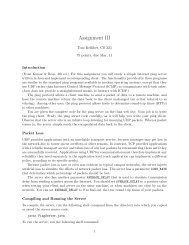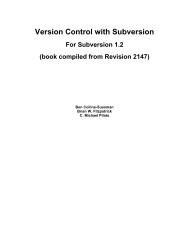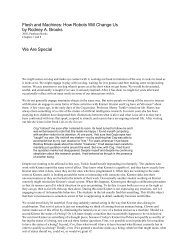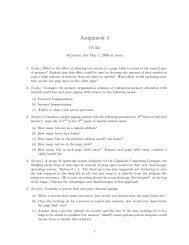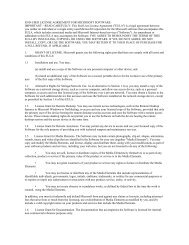- Page 1 and 2: RAPL-3 Language Reference Guide UMI
- Page 3 and 4: RAPL-3 Reference Guide iii CRS Lice
- Page 5 and 6: RAPL-3 Reference Guide v External C
- Page 7 and 8: RAPL-3 Reference Guide vii Contents
- Page 9 and 10: Contents RAPL-3 Reference Guide ix
- Page 11 and 12: RAPL-3 Reference Guide xi Chapter 7
- Page 13 and 14: RAPL-3 Reference Guide xiii call_if
- Page 15 and 16: RAPL-3 Reference Guide xv malarm ..
- Page 17 and 18: RAPL-3 Reference Guide xvii sig_arm
- Page 19 and 20: Preface This guide is a reference m
- Page 21 and 22: RAPL-3 Reference Guide 3 Commands a
- Page 23 and 24: C HAPTER 1 General Program Format A
- Page 25 and 26: subroutine main function RAPL-3 Ref
- Page 27 and 28: Lines of a Program RAPL-3 Reference
- Page 29 and 30: Labels RAPL-3 Reference Guide 11 A
- Page 31 and 32: C HAPTER 2 Data Types and Variables
- Page 33 and 34: RAPL-3 Reference Guide 15 gloc [Not
- Page 35 and 36: Declarations RAPL-3 Reference Guide
- Page 37 and 38: Strings RAPL-3 Reference Guide 19 T
- Page 39 and 40: Arrays RAPL-3 Reference Guide 21 An
- Page 41 and 42: RAPL-3 Reference Guide 23 Teachable
- Page 43 and 44: RAPL-3 Reference Guide 25 Storage C
- Page 45 and 46: RAPL-3 Reference Guide 27 Pointers
- Page 47 and 48: Record Structures RAPL-3 Reference
- Page 49: RAPL-3 Reference Guide 31 Initializ
- Page 53 and 54: CHAPTER 3 Expressions, Assignment,
- Page 55 and 56: RAPL-3 Reference Guide 37 Assignmen
- Page 57 and 58: RAPL-3 Reference Guide 39 Symbol Fo
- Page 59 and 60: CHAPTER 4 Constants For the most pa
- Page 61 and 62: String Constants RAPL-3 Reference G
- Page 63 and 64: Location Constants RAPL-3 Reference
- Page 65 and 66: CHAPTER 5 Control Flow When a progr
- Page 67 and 68: RAPL-3 Reference Guide 49 message_1
- Page 69 and 70: RAPL-3 Reference Guide 51 expressio
- Page 71 and 72: RAPL-3 Reference Guide 53 (b) if wi
- Page 73 and 74: RAPL-3 Reference Guide 55 false (eq
- Page 75 and 76: CHAPTER 6 Subroutines, Functions an
- Page 77 and 78: RAPL-3 Reference Guide 59 Kinds of
- Page 79 and 80: RAPL-3 Reference Guide 61 Where mai
- Page 81 and 82: RAPL-3 Reference Guide 63 sub beta(
- Page 83 and 84: RAPL-3 Reference Guide 65 Libraries
- Page 85 and 86: RAPL-3 Reference Guide 67 Relevant
- Page 87 and 88: CHAPTER 7 Preprocessor Directives W
- Page 89 and 90: RAPL-3 Reference Guide 71 What has
- Page 91 and 92: RAPL-3 Reference Guide 73 Preproces
- Page 93 and 94: RAPL-3 Reference Guide 75 .include
- Page 95 and 96: CHAPTER 8 Structured Exception Hand
- Page 97 and 98: RAPL-3 Reference Guide 79 A subprog
- Page 99 and 100: CHAPTER 9 Library Subprograms The l
- Page 101 and 102:
RAPL-3 Reference Guide 83 Where a f
- Page 103 and 104:
RAPL-3 Reference Guide 85 DELAY del
- Page 105 and 106:
RAPL-3 Reference Guide 87 ONSIG loo
- Page 107 and 108:
RAPL-3 Reference Guide 89 @ACCEL ac
- Page 109 and 110:
Subprograms: Category Listing These
- Page 111 and 112:
RAPL-3 Reference Guide 93 Win 32 Th
- Page 113 and 114:
Calibration RAPL-3 Reference Guide
- Page 115 and 116:
Date and Time RAPL-3 Reference Guid
- Page 117 and 118:
RAPL-3 Reference Guide 99 Digital I
- Page 119 and 120:
RAPL-3 Reference Guide 101 Error Me
- Page 121 and 122:
RAPL-3 Reference Guide 103 ENOCLIEN
- Page 123 and 124:
RAPL-3 Reference Guide 105 File Inp
- Page 125 and 126:
RAPL-3 Reference Guide 107 File and
- Page 127 and 128:
Front Panel RAPL-3 Reference Guide
- Page 129 and 130:
Gripper RAPL-3 Reference Guide 111
- Page 131 and 132:
Location RAPL-3 Reference Guide 113
- Page 133 and 134:
Memory RAPL-3 Reference Guide 115 h
- Page 135 and 136:
RAPL-3 Reference Guide 117 jog_ws w
- Page 137 and 138:
RAPL-3 Reference Guide 119 teach_me
- Page 139 and 140:
Robot Configuration RAPL-3 Referenc
- Page 141 and 142:
RAPL-3 Reference Guide 123 xpulses_
- Page 143 and 144:
Stance RAPL-3 Reference Guide 125 U
- Page 145 and 146:
String Manipulation RAPL-3 Referenc
- Page 147 and 148:
RAPL-3 Reference Guide 129 System P
- Page 149 and 150:
RAPL-3 Reference Guide 131 Tool Tra
- Page 151 and 152:
RAPL-3 Reference Guide 133 shell da
- Page 153 and 154:
RAPL-3 Reference Guide 135 v3_new C
- Page 155 and 156:
RAPL-3 Reference Guide 137 NPIPE_ST
- Page 157 and 158:
Subprograms: Alphabetical Listing S
- Page 159 and 160:
RAPL-3 Reference Guide 141 RAPL-II
- Page 161 and 162:
RAPL-3 Reference Guide 143 3 879 26
- Page 163 and 164:
RAPL-3 Reference Guide 145 RAPL-II
- Page 165 and 166:
RAPL-3 Reference Guide 147 correspo
- Page 167 and 168:
RAPL-3 Reference Guide 149 Result I
- Page 169 and 170:
RAPL-3 Reference Guide 151 ;; inclu
- Page 171 and 172:
RAPL-3 Reference Guide 153 Example
- Page 173 and 174:
RAPL-3 Reference Guide 155 Paramete
- Page 175 and 176:
RAPL-3 Reference Guide 157 end func
- Page 177 and 178:
RAPL-3 Reference Guide 159 ... cfg_
- Page 179 and 180:
RAPL-3 Reference Guide 161 chdir De
- Page 181 and 182:
RAPL-3 Reference Guide 163 Paramete
- Page 183 and 184:
Category Win 32 RAPL-3 Reference Gu
- Page 185 and 186:
RAPL-3 Reference Guide 167 Paramete
- Page 187 and 188:
RAPL-3 Reference Guide 169 trig1[0,
- Page 189 and 190:
RAPL-3 Reference Guide 171 speed_se
- Page 191 and 192:
RAPL-3 Reference Guide 173 new file
- Page 193 and 194:
RAPL-3 Reference Guide 175 Example
- Page 195 and 196:
RAPL-3 Reference Guide 177 Example
- Page 197 and 198:
RAPL-3 Reference Guide 179 See Also
- Page 199 and 200:
RAPL-3 Reference Guide 181 Returns
- Page 201 and 202:
RAPL-3 Reference Guide 183 finish D
- Page 203 and 204:
RAPL-3 Reference Guide 185 Result C
- Page 205 and 206:
RAPL-3 Reference Guide 187 -EINTR t
- Page 207 and 208:
RAPL-3 Reference Guide 189 gains_se
- Page 209 and 210:
RAPL-3 Reference Guide 191 string[]
- Page 211 and 212:
RAPL-3 Reference Guide 193 printf(
- Page 213 and 214:
RAPL-3 Reference Guide 195 Argument
- Page 215 and 216:
RAPL-3 Reference Guide 197 Descript
- Page 217 and 218:
RAPL-3 Reference Guide 199 See Also
- Page 219 and 220:
RAPL-3 Reference Guide 201 here Des
- Page 221 and 222:
RAPL-3 Reference Guide 203 Syntax f
- Page 223 and 224:
Returns RAPL-3 Reference Guide 205
- Page 225 and 226:
RAPL-3 Reference Guide 207 See Also
- Page 227 and 228:
RAPL-3 Reference Guide 209 WORLD_XR
- Page 229 and 230:
RAPL-3 Reference Guide 211 Returns
- Page 231 and 232:
RAPL-3 Reference Guide 213 Returns
- Page 233 and 234:
RAPL-3 Reference Guide 215 Category
- Page 235 and 236:
RAPL-3 Reference Guide 217 loc_cdat
- Page 237 and 238:
RAPL-3 Reference Guide 219 flags =
- Page 239 and 240:
RAPL-3 Reference Guide 221 See Also
- Page 241 and 242:
RAPL-3 Reference Guide 223 Result1
- Page 243 and 244:
RAPL-3 Reference Guide 225 Example
- Page 245 and 246:
RAPL-3 Reference Guide 227 ;; Set e
- Page 247 and 248:
RAPL-3 Reference Guide 229 Paramete
- Page 249 and 250:
RAPL-3 Reference Guide 231 MOUNT_HO
- Page 251 and 252:
RAPL-3 Reference Guide 233 mtime De
- Page 253 and 254:
RAPL-3 Reference Guide 235 Example
- Page 255 and 256:
RAPL-3 Reference Guide 237 end if e
- Page 257 and 258:
Returns RAPL-3 Reference Guide 239
- Page 259 and 260:
RAPL-3 Reference Guide 241 state th
- Page 261 and 262:
RAPL-3 Reference Guide 243 Descript
- Page 263 and 264:
RAPL-3 Reference Guide 245 Paramete
- Page 265 and 266:
RAPL-3 Reference Guide 247 panel_li
- Page 267 and 268:
RAPL-3 Reference Guide 249 Paramete
- Page 269 and 270:
RAPL-3 Reference Guide 251 Example
- Page 271 and 272:
Result child read - 1 child read -
- Page 273 and 274:
RAPL-3 Reference Guide 255 pos_axis
- Page 275 and 276:
RAPL-3 Reference Guide 257 The vari
- Page 277 and 278:
RAPL-3 Reference Guide 259 See Also
- Page 279 and 280:
RAPL-3 Reference Guide 261 (server
- Page 281 and 282:
RAPL-3 Reference Guide 263 readline
- Page 283 and 284:
RAPL-3 Reference Guide 265 Result c
- Page 285 and 286:
RAPL-3 Reference Guide 267 robot_fl
- Page 287 and 288:
RAPL-3 Reference Guide 269 See Also
- Page 289 and 290:
RAPL-3 Reference Guide 271 else ;;h
- Page 291 and 292:
RAPL-3 Reference Guide 273 Paramete
- Page 293 and 294:
RAPL-3 Reference Guide 275 Paramete
- Page 295 and 296:
RAPL-3 Reference Guide 277 sem_rele
- Page 297 and 298:
RAPL-3 Reference Guide 279 See Also
- Page 299 and 300:
RAPL-3 Reference Guide 281 value le
- Page 301 and 302:
RAPL-3 Reference Guide 283 shift_t(
- Page 303 and 304:
RAPL-3 Reference Guide 285 Paramete
- Page 305 and 306:
RAPL-3 Reference Guide 287 sigsend
- Page 307 and 308:
RAPL-3 Reference Guide 289 Example
- Page 309 and 310:
RAPL-3 Reference Guide 291 ... if (
- Page 311 and 312:
RAPL-3 Reference Guide 293 Returns
- Page 313 and 314:
RAPL-3 Reference Guide 295 elbow_t
- Page 315 and 316:
RAPL-3 Reference Guide 297 string[P
- Page 317 and 318:
RAPL-3 Reference Guide 299 str_chr_
- Page 319 and 320:
RAPL-3 Reference Guide 301 Example
- Page 321 and 322:
RAPL-3 Reference Guide 303 Length,
- Page 323 and 324:
RAPL-3 Reference Guide 305 Category
- Page 325 and 326:
RAPL-3 Reference Guide 307 Paramete
- Page 327 and 328:
RAPL-3 Reference Guide 309 int sc_m
- Page 329 and 330:
RAPL-3 Reference Guide 311 Paramete
- Page 331 and 332:
RAPL-3 Reference Guide 313 tx Alias
- Page 333 and 334:
RAPL-3 Reference Guide 315 Returns
- Page 335 and 336:
RAPL-3 Reference Guide 317 arm posi
- Page 337 and 338:
RAPL-3 Reference Guide 319 System S
- Page 339 and 340:
RAPL-3 Reference Guide 321 Syntax c
- Page 341 and 342:
RAPL-3 Reference Guide 323 var_teac
- Page 343 and 344:
RAPL-3 Reference Guide 325 WEXITSTA
- Page 345 and 346:
RAPL-3 Reference Guide 327 write De
- Page 347 and 348:
RAPL-3 Reference Guide 329 wx Alias
- Page 349 and 350:
RAPL-3 Reference Guide 331 Returns
- Page 351 and 352:
RAPL-3 Reference Guide 333 Category
- Page 353 and 354:
RAPL-3 Reference Guide 335 See Also
- Page 355 and 356:
RAPL-3 Reference Guide 337 Example
- Page 357 and 358:
RAPL-3 Reference Guide 339 zrots Al
- Page 359 and 360:
APPENDICES Signals Symbol Number De



